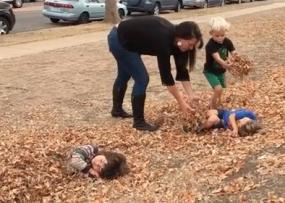Leaves - Making connections with peers and nature

Oto has covered herself with leaves. Logan and Cayetano come over to see what she is doing. The teacher explains that she’s “getting covered up,” and Cayetano excitedly asks, “Can you do that to me?”
What makes it fun for children to cover themselves up with leaves? Perhaps the fun resides in the paradox of creating a sense of coziness out-of-doors. Children may enjoy reversing a primary attribute of the open outdoor space.
Cayetano moves away and lies down, saying, “I can do it over here.” He selects a spot on the ground with quite a bit of leaves, perhaps thinking, “If I am going to be covered then I am going to need a supply of leaves.” He lays in the same direction as Oto and also gets on his side as if he is pretending to sleep (00:16). Cayetano may want to make a connection with his peer by adopting her pretend play theme. Through pretense, he also creates a scenario where he needs to be covered up as he sleeps.
Oto’s body is only half-visible. Curiously, no one suggests covering her all the way up. The children might be concerned that Oto needs to breathe. Or, the children may want to be able to see the person, and the leaves are a type of camouflage, rather than concealment. If they covered Oto all the way up then others could not see that she is pretending to sleep. Oto takes on a canonical symbolization for sleeping, lying on her side with her head resting on tucked hands. The children may read her symbolism and understand that Oto adds to the context of her pretend sleeping by using the leaves as a blanket.
The teacher asks Oto if she is cozy. Oto does not want to wake up from her pretend sleep in order to answer the teacher’s question. Instead, she smiles and briefly opens her eyes (00:18). Cleverly, she has invented a way to talk to the teacher without leaving her pretense. The teacher acknowledges that Oto wants to go on pretend sleeping by saying, “Oh, shhh. Night, night.”
Stone tiptoes past Oto as she sleeps (00:23). By embracing the theme he becomes part of the story. One wonders if children know why you tiptoe when someone is sleeping or if they tiptoe from rote memory. Does Stone understand the cause and effect relationship – that making noise may cause someone to wake?
Earlier in the video, the teacher encouraged Cayetano to cover himself up with leaves (00:08), perhaps hoping the boy would give her an indication of what he meant by covering. Cayetano again asks, “Can you put some on me?” The teacher revises her instructions and says, “You start it, like you have to cover your legs. (00:29). By changing “put some on me” to “put some on your legs,” she is saying that the leaves are a covering, not a burying or a hiding. As if to acknowledge the difficulty of covering one’s own legs, the teacher encourages the boy. She says, “Give it a try” (00:32).
Stone offers to cover Cayetano with leaves. He may want to establish a role in the play. Or, Stone may appreciate that it is hard for Cayetano to cover his own legs because the movement will knock the leaves off of his body. Notice that Stone does not just start putting leaves on the boy’s legs - he asks permission. By saying, “Cayetano, I can cover you” (00:35), Stone lets it be known that he wants to help but he does not want to infringe on Cayetano.
In a precise fashion, the teacher covers Cayetano’s feet. She may try to guide the placement of the leaves in anticipation that Stone might try to cover Cayetano’s head. Nearby, Oto shows restraint as she resists looking over at what the boys and teacher are doing (00:44). Of course, she might be very comfortable under her blanket of leaves. Oto might also know that by moving her body she risks disturbing the leaves.
Some leaves fall onto Cayetano’s face, and the teacher offers a helpful reminder, “Oh, not on his face. You gotta mostly do his legs.” Stone then takes extra care to check with Cayetano directly by saying, “You want me to do it on your face?” and Stone replies, “No” (00:51). Stone says, “Okay” and shares, “I did it once on my face,” perhaps recalling an enjoyable experience being buried under leaves. The teacher resumes working to guide the placement of the leaves by adding more to Cayetano’s feet and sculpting the pile to make it cozy (00:53).
With anticipation in her voice, the teacher says, “Oh, here comes the wind!” Note that she does not simply comment by saying, “Oh, it’s windy.” Why might the teacher choose to announce the arrival of the wind? Instantly, the two boys stop and stand still (01:00). One boy’s hair flutters in the wind. The children likely know that they read the wind speed and direction better when standing still. Oto also lifts her head to feel the wind (01:03). As if in shared recognition that the wind is fleeting, the children pause to enjoy the invisible force.
A boy (off camera) announces, “The wind is blowing the house down!” Perhaps inviting the children to make a judgment about the force of the wind, the teacher skeptically says, “It is?” Just then, we hear a crash (01:09). The teacher calmly confirms by saying, “It is.” As the children run to build the house again, they acknowledge that wind is a force that can blow things over.
Keywords: fours, leaves, outdoors, pretense, nature, children-teacher
Length of video: 1 minute 26 seconds
